Migration Assistant copies all of your files to your new Mac so that you don't have to copy your files manually.
Apr 20, 2018 Migrate Files and Apps from macOS to Windows 10. Microsoft is stepping up its game, both in the operating system and the hardware departments.
- If your files are currently on a Windows PC, follow the PC migration steps instead.
- If your new Mac is using OS X Mountain Lion v10.8 or earlier, follow the Mountain Lion migration steps instead.
Check software, settings, and power
Transferring Apps To A Different Mac Laptop

- Dec 05, 2017 I have a MacBook Air 10.13.1, iTunes 12.7.1.14 and an iPhone 11.2. I know that iTunes no longer manages apps. I have valid, purchased apps on my MacBook Air that are NOT on my iPhone. They were in fact copied from the iTunes library to an external USB drive to save space. How can I transfer these apps from my MacBook Air to my iPhone?
- Transfer Apps to iPhone on Mac without iTunes. If you want to get rid of the sync of iTunes, you can take advantage of the third-party iPhone transfer for Mac. Among all the data transfer programs for iOS devices, Leawo iTransfer for Mac can be regarded as one of the best. The software enables users to transfer files among iOS devices.
- Install all available Apple software updates on both Mac computers. Install any updates for your third-party apps as well.
- Make sure that your old Mac is using OS X Lion or later.
- Make sure that your old Mac has a computer name: Choose Apple menu > System Preferences, then click Sharing and check the Computer Name field.
- Connect both computers to AC power.
Connect the computers to each other
- If both computers are using macOS Sierra or later, just make sure that they're near each other and have Wi-Fi turned on. If either is using OS X El Capitan or earlier, connect them to the same network using Wi-Fi or Ethernet.
- Or connect them using target disk mode and the appropriate cable or adapter. Then start up your old computer in target disk mode.
- Or connect your new Mac to a Time Machine backup of your old Mac.
Use Migration Assistant
On your new Mac:
Move Apps To New Macbook
- Open Migration Assistant, which is in the Utilities folder of your Applications folder.
- Click Continue.
- When asked how you want to transfer your information, select the option to transfer from a Mac, Time Machine backup, or startup disk.
- Click Continue.
On your old Mac:
If you started your old Mac in target disk mode or are migrating from a Time Machine backup, skip these four steps.
- Open Migration Assistant.
- Click Continue.
- When asked how you want to transfer your information, select the option to transfer to another Mac.
- Click Continue.

On your new Mac:
- When asked to select a Mac, Time Machine backup, or other startup disk, click the appropriate icon.
- Click Continue. You might see a security code.
On your old Mac:
If you started your old Mac in target disk mode or are migrating from a Time Machine backup, skip these two steps.
- If you see a security code, make sure that it's the same code as on your new Mac.
- Click Continue.
On your new Mac:
- Choose the backup to transfer information from.
- Click Continue.
Continuing on your new Mac:
- Select the information to transfer from the backup.
- Click Continue to start the transfer. If you have a lot of content, the transfer might take several hours to finish.
In the example above, John Appleseed is a macOS user account. If you transfer an account that has the same name as an account on your new Mac, you're asked to rename the old account or replace the one on your new Mac. If you rename, the old account appears as a separate user on your new Mac, with a separate home folder and login. If you replace, the old account overwrites the account on your new Mac, including everything in its home folder.
After Migration Assistant is done, log in to the migrated account on your new Mac to see its files. If you're not keeping your old Mac, learn what to do before you sell, give away, or trade in your old Mac.
For the former just change the permissions on an inaccessible application:
1. Select the application. Press COMMAND-I to open the Get Info window. At the bottom is the pane for Ownership and Sharing.
2. The correct settings should be:
Owner=system with r/w privileges
Group=wheel with read-only privileges
Everyone is read-only
If the owner is a username then you need to change the permissions as follows.
3. Open the Terminal application in your Utilities folder. At the prompt enter:
sudo chown -R root:wheelPut a space after 'wheel' then drag the icon of the application into the Terminal window. Press RETURN. Enter your admin password when prompted. It will not be echoed. Press RETURN again.
If you have more than one application whose permissions need to be changed then select all of them and drag them into the Terminal window instead of just the one.
For the latter if the other user account is a Standard or Managed account, then you have to assign what applications that user can access via Parental Controls preferences or change the account to an admin account.

Mar 4, 2011 10:07 AM



